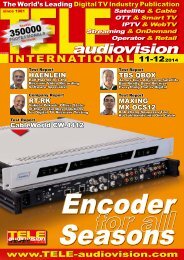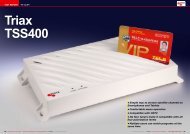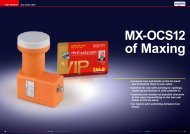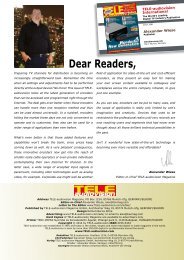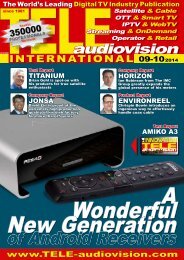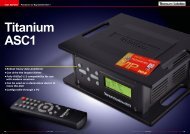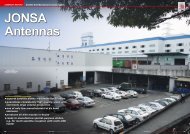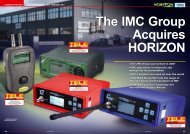eng TELE-audiovision 1305
The World’s Largest Digital TV Trade Magazine
The World’s Largest Digital TV Trade Magazine
Create successful ePaper yourself
Turn your PDF publications into a flip-book with our unique Google optimized e-Paper software.
duty charges could be significantly<br />
high. Note that along with the SL3 you<br />
would also need a B-band converter<br />
(often labeled BBC). The DirecTV SL3<br />
LNB would cost about US$30 and the<br />
B-band converter would run about<br />
US$10. Don‘t forget to factor in the<br />
shipping costs and the customs duties.<br />
For this report I experimented with<br />
both LNBs with the following results:<br />
The LNB for the Irish TV provider<br />
is very easy to work with since it fits<br />
nicely in a standard universal LNB<br />
mount. Simply replace the existing<br />
universal LNB with this one and just<br />
like that you‘re working in the Ka-band<br />
although it‘ll only be in the 19.7 to 20.2<br />
GHz range.<br />
If you install this LNB in an existing<br />
motorized antenna system, you‘ll<br />
quickly get a feel for what‘s out there<br />
in the Ka-band. You can drive the antenna<br />
to every known satellite position<br />
and use a signal analyzer to see<br />
if there are any active Ka-band transponders.<br />
To make a long story short, from<br />
my location here in Portugal with this<br />
„White Ka“ LNB I could only identify<br />
one transponder at 13.0E and eight<br />
transponders at 9.0E. The transponders<br />
on EUTELSAT 9.0E belong to the<br />
TooWay Internet service. The single<br />
transponder on HOTBIRD at 13.0E is<br />
also used for satellite-based Internet<br />
service. To confirm this I connected<br />
an older satellite modem and, sure<br />
enough, I was able to achieve a lock<br />
on that corresponding frequency.<br />
But that was it! With this LNB and<br />
an 80cm antenna there were no other<br />
transponders that could be found from<br />
39.0E to 30.0W.<br />
Why couldn‘t I receive the Irish TV<br />
provider Saorsat? They broadcast seven<br />
RTÉ channels in DVB-S2 that happen<br />
to be unencrypted. The answer is<br />
quite simple: EUTELSAT 9.0E utilizes<br />
spot beams. With these extremely<br />
Input<br />
output<br />
99.0W (Ka-Band) 101.0W (Ku-Band) 103.0W (Ka-Band)<br />
Low: 18.3-18.8 GHz<br />
High: 19.7-20.2 GHz<br />
Low: 250-750MHz<br />
High: 1660-2150MHz<br />
small footprints, this package can be<br />
beamed with great precision to Ireland;<br />
even along the British coast, with<br />
a few exceptions, nothing can be received<br />
anymore.<br />
These spot beams provide the following<br />
advantages for a satellite provider:<br />
• Transponders can be broadcast to<br />
very clearly defined regions and that<br />
basically eliminates the need for encryption<br />
like that taking place in Austria<br />
for example.<br />
• The transponder frequencies can<br />
be used much more efficiently since<br />
the same frequency can be reused in<br />
other spot beams. TooWay essentially<br />
uses the same frequency across all of<br />
Europe but depending on your location,<br />
different transponders would be<br />
used. This technique would allow the<br />
use of significantly higher bandwidths<br />
than could be used before.<br />
And, with that, the<br />
test of this Ka-band<br />
LNB came to<br />
an end. Since<br />
TooWay does<br />
not use QPSK<br />
12.2-12.7 GHz<br />
950-1450MHz<br />
Low: 18.3-18.8 GHz<br />
High: 19.7-20.2 GHz<br />
Low: 250-750MHz<br />
High: 1660-2150MHz<br />
or 8PSK modulation, I couldn‘t do anything<br />
with these transponders.<br />
Next was the SL3 LNB from DirecTV.<br />
This LNB is actually made up of three<br />
LNBs all built into one metallic form as<br />
a multifeed LNB. This multifeed LNB<br />
also has a built-in multiswitch that<br />
feeds the three satellite signals to four<br />
independent outputs. As is typical with<br />
multifeeds, these LNBs are mounted<br />
in such a way that the three satellites<br />
(99.0W, 101.0W and 103.0W) can all be<br />
received at the same time.<br />
This created problems with DXers,<br />
especially with motorized antennas,<br />
since the two Ka LNBs are positioned<br />
in such a way that a two degree correction<br />
is needed. With DiSEqC motors<br />
like the SG2100 you can expect four<br />
impulses per degree.<br />
The table at top puts it all together<br />
for the SL3 LNB (table 2).<br />
The LNBs polarization is left or right<br />
www.<strong>TELE</strong>-<strong>audiovision</strong>.com — 05-06/2013 — <strong>TELE</strong>-<strong>audiovision</strong> International — 全球发行量最大的数字电视杂志 131<br />
■<br />
Ka-band LnB<br />
mounted at a rotary<br />
60cm consumer dish




